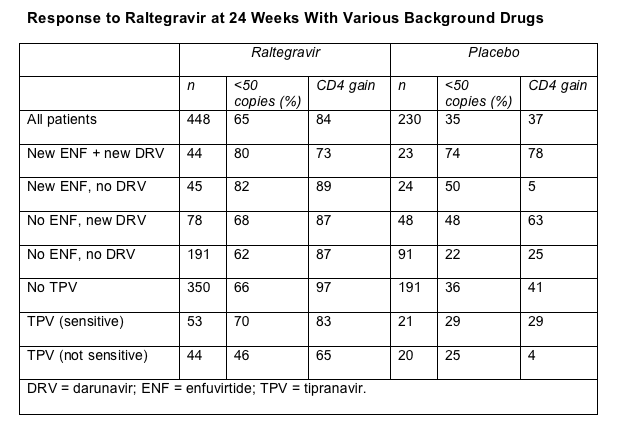 |
 |
 |
| |
Combined 24-Week Efficacy Data on the Integrase Inhibitor Raltegravir
|
| |
| |
11th European AIDS Conference
October 24-27, 2007
Madrid
Mark Mascolini
Raltegravir, the integrase inhibitor recently licensed in the US as Isentress, passed a 24-week double-trial efficacy test with flying colors, BENCHMRK-1 and -2 investigators reported at the European AIDS Conference in Madrid [1]. The only bad news for Merck, raltegravir's maker, in this 667-person analysis is that most people with triple-class resistance who can start active enfuvirtide and darunavir can probably save raltegravir for another day. Or they may opt for the twice-daily raltegravir pill right away instead of using the twice-daily enfuvirtide shots.
Because the two BENCHMRK trials follow the same format, researchers could combine 24-week results to afford a more robust look at how to use this muscular new med. These double-blind trials enrolled people with virus resistant to some drugs in the first three antiretroviral classes, a viral load above 1000 copies, and any CD4 count. BENCHMRK 1 took place in Europe, Peru, and the Asia/Pacific region, and BENCHMRK-2 in North and South America. Study participants got randomized to 400 mg of raltegravir twice daily or placebo plus a background regimen tailored for potential potency against each person's resistant virus.
After 24 weeks a noncompleter-equals-failure analysis determined that 75% taking raltegravir had a viral load under 400 copies (versus 40% with placebo) and 63% on raltegravir had fewer than 50 copies (versus 34% with placebo). While the raltegravir group gained an average 84 CD4 cells, the placebo group gained an average 37 (P < 0.001 for all three of these primary endpoint comparisons).
Raltegravir-based salvage regimens outpaced rescue regimens without raltegravir regardless of which other potent drugs a person took (Table). A virologic-failure-carried-forward analysis showed that 4 in 5 people who started the integrase inhibitor with first-time enfuvirtide and first-time darunavir reached a viral load below 50 copies in 24 weeks. That looked slightly better than the 74% sub-50 response rate among people starting enfuvirtide and darunavir for the first time without raltegravir, but the difference probably lacks statistical significance. (Note that numbers of people in some of these subgroups are small, especially for placebo.)

Among people who started only enfuvirtide or only darunavir for the first time in the BENCHMRK trials, raltegravir easily outshone placebo (Table). Study participants with tipranavir-sensitive virus who started that protease inhibitor with raltegravir did just as well as people who started darunavir with raltegravir (and without enfuvirtide), at least through 24 weeks (Table). CD4 gains also proved superior with raltegravir than with placebo, even when placebo takers had a relatively good virologic response at week 24 (Table).
Even among people with a genotypic sensitivity score (GSS) of 0, indicating little or no activity of background drugs, 44% notched a 24-week viral load below 50 copies, compared with 6% for placebo. When the GSS rose to 1, 71% had a sub-50 response to raltegravir versus 37% for placebo. With a GSS of 2 or more, 71% responded to the raltegravir regimen and 56% to the placebo regimen.
This report did not compare side effects in the raltegravir and placebo groups--or between different raltegravir backgrounds such as darunavir versus tipranavir.
Reference
1. Kumar P, Cooper D, Steigbigel R, et al. Efficacy of raltegravir, an HIV integrase inhibitor, in combination with regimens containing enfuvirtide, darunavir, or tipranavir in patients with triple-class resistant virus: combined results from Benchmrk-1 and Benchmrk-2. European AIDS Conference. October 24-27, 2007. Madrid. Abstract P7.2/06.
|
| |
|
 |
 |
|
|